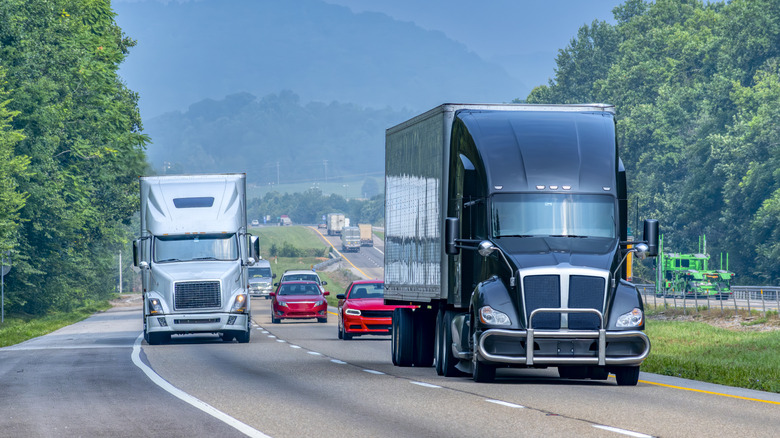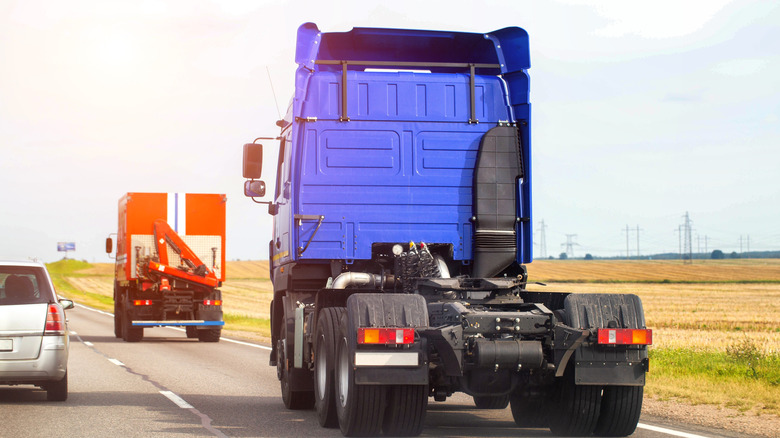Does Driving Behind A Semi-Truck Really Save On Gas?
There are many methods to avoid wasting fuel floating around the internet and pub counters; a few are urban legends, and many more actually work. From running your car in a higher gear to cruising at lower speeds, there are various ways in which people have gotten the practice of hypermiling down to a science. But what about driving close to a truck — or, indeed, any other vehicle in front of you on the highway?
It's been tested before on MythBusters, in fact, and the team found that, yes, driving a passenger car behind a truck will save you a decent amount of fuel, depending on the distance and type of vehicle you're driving. But what is the exact metric behind this, how does it save you on fuel, and is there a way to do this safely? As a quick refresher, the data acquired from the MythBusters test states that a Dodge Magnum traveling at incrementally closer distances to a big rig will, in fact, show a proportionate increase in fuel saving, up to a point. If a car gets too close, then the management of the throttle to keep it at that specific distance will negatively affect fuel consumption.
So there's a sweet spot in there based on factors like blind spots, the speed the truck is going, and what sort of car you're driving. This sort of practice benefits fuel economy across the board, though less aerodynamic vehicles like SUVs may benefit more. However, as a reminder, never tailgate a truck to the point where you cannot see; that's dangerously unsafe. All that said, let's dive into the science behind aerodynamic drag and how it impacts fuel efficiency, and how you as a driver can exploit that to gain some extra mpg.
The science behind drafting
When you're driving a car at speed, it gets subjected to an increasing amount of air resistance, which is defined by the amount of air that the car must move out of the way. Depending on whether your car is or isn't aerodynamically efficient, this means either slicing through the air or compressing it in front of the car. The amount of drag a car experiences increases exponentially the faster it goes, starting at almost zero in city traffic to parasitic at triple-digit speeds. Overcoming this requires one of two factors: changing the shape of the car, or changing the airflow around it.
The second factor is the reason why NASCAR stock cars draft each other in extreme proximity. Drafting is defined as driving close to another vehicle in such a way that you're effectively inside the low-pressure bubble behind that car. In other words, the car in front slices through the air, so your car doesn't have to, and therefore you encounter less air resistance, but also less air available for the radiator and other elements.
This principle applies outside of the racing circuit as well, albeit less dramatically since the speeds are far slower. But physics are physics — therefore, driving behind a truck will, in fact, produce the same effect. Of course, you won't need to worry about high-speed cornering or anything like a Formula One car, so the detriments apply far less in a daily driving scenario. There are a few mpg myths out there, but this is a very real and often-used phenomenon.
Can you do it safely?
In principle, the only thing that tailgating a truck does is manipulate a vehicle's aerodynamic efficiency, albeit temporarily. Ideally you'd want to do something more permanent, such as eliminating superfluous components like a roof caddy or buying a fuel efficient car from the get-go, of which there are many. Hypermilers often drive cars heavily optimized for this sort of effect, even going so far as to extensively modify the bodies of their cars to produce low drag coefficients. But for the rest of us, driving behind a truck seems like a fair substitute, especially if you own something particularly aerodynamically poor like a Jeep Wrangler. However, therein lies two problems: proximity and diminishing returns.
First of all, it's dangerously unsafe to tailgate, certainly when you're talking about tailgating a truck that totally blocks your frontal view. It prevents you from seeing any potential reasons for stopping, such as an upcoming traffic jam, construction zone, etc. Moreover, maintaining a close distance requires precise throttle and braking which, as stated before, negatively impacts mpg.
The ideal situation, therefore, is to simply sit within a safe following distance. Even within 100 feet, one study shows, from Altair, that there are reductions as much as 10% in a typical car's coefficient of drag at highway speeds. Overall, yes, this practice can be done safely and still produce a noticeable benefit, so long as you bear in mind that you need enough time to react if the truck suddenly brakes or veers out of the way of an obstacle.


